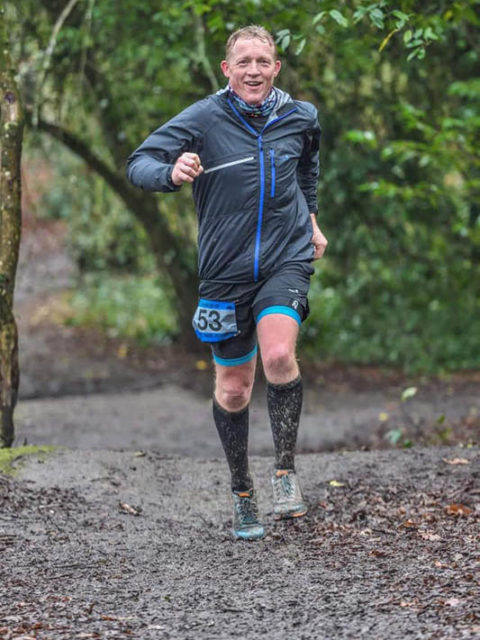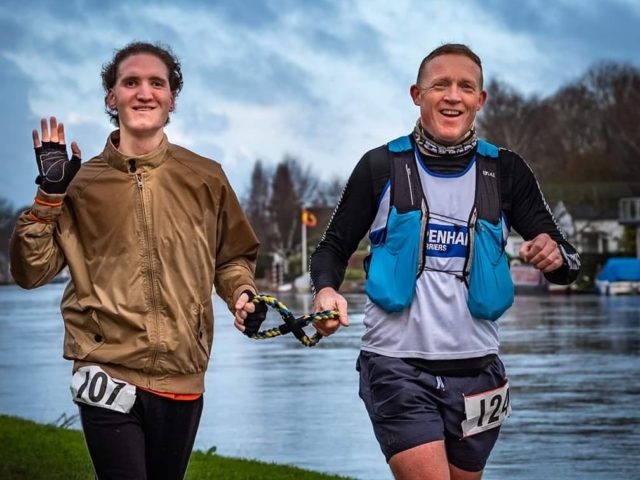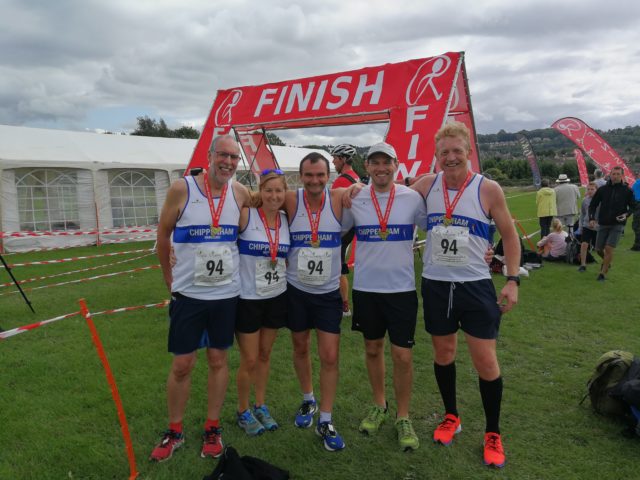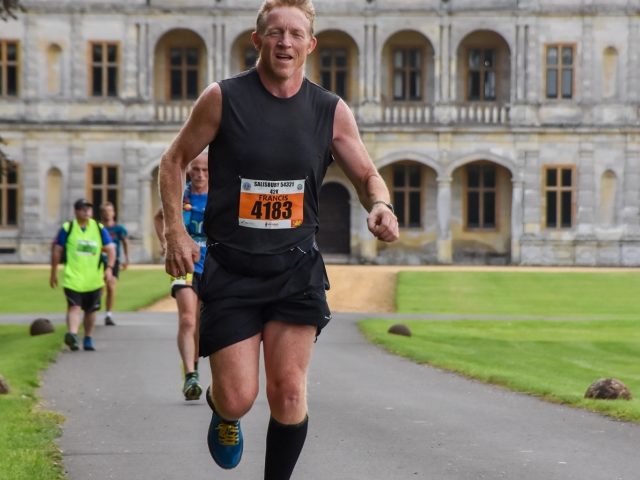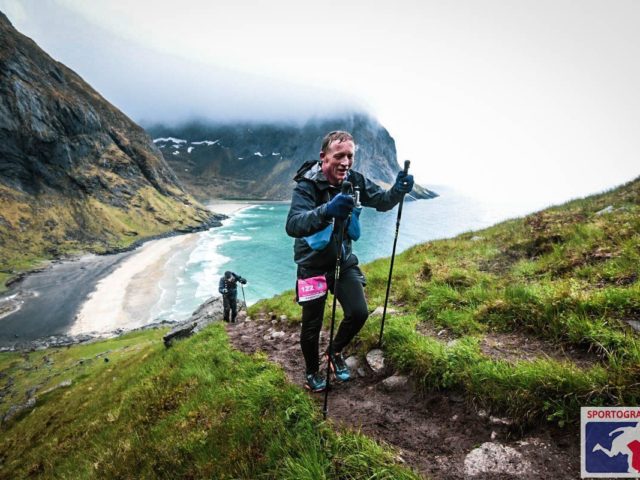Counting up every timed event I ran 44 events in 2019 and raced and trained for 2000 miles (exactly, as it happens!)
As I have chosen 20 highlight events for 2020, here are the 19 that stood out in 2019.
This was a PB race, lowering my 10K to 40.40, largely courtesy of the Nike shoes that stuck on for the second time in a week since unboxing them. The race itself is nothing fancy, a there and back on a flat road, tail wind for 5K, head for 5K. My first 5K was a wind assisted 19.19, also a PB, if such things count. What I really enjoyed about this run – the shoes, the light-footed feel they gave me was pure pleasure. I never wanted to be a slave to Nike, but they have moved the whole road running thing forwards. One more reason to give up road?
18: Broad Town 5
AKA the redemption run as 2 years ago this middle of summer local 5 miler near Swindon, organised by Wootton Bassett Hounds was the race where I blanked out mid stride in mid-30 degrees heat, and yet my legs carried on running. Various calamities followed resulting in me running the wrong direction when I came to, being hosed down by a bewildered estate worker, pointed back on track, and finally staggering to the finish. This year I put Broad Town to the sword in 31 mins, knocking more than 15 off my previous attempt, and no frowns from St Johns. That’s a win.
17: Chippenham Parkrun
19.39 was a new Park Run PB, though I don’t run very many. What a simple joy it is though, to run one of these events. The community, the friendship, the appreciation of each other and our surrounds… just wonderful.
A friendly low-key road marathon when all eyes are on the big dates of the spring season – London, Brighton, Paris, Manchester, Newport… It is flat and PB-able, less than 1000 runners. Quite possibly the risk of getting a windy day is off-putting to time-chasers. And wind we got.
But we also got an excellent 3.30 pacer and this was a race that I got tactically right, going after my 3.33 previous PB, reducing the wind disadvantage in the pacer pack as much as the biggest runner in the pack could, and finally giving up the shelter to press for the line with 3 miles left. The result, 3.27, a new PB, the best possible result on the day in conditions that I could have allowed to beat me mentally.
The event is back with a different route for 2020
15: Heddington 5K
Running Heddington alongside friends from my local Wiltshire running clubs is so special. This series of 4 events from Calne Running Club has a magic about it, and race one in the series was one of those golden evenings. A new PB for me in this one too at the time, though Heddington has a downhill profile that some don’t count for PBs. It didn’t matter. I beat the time again later the same week. My time wasn’t why this event was so good. Heddington, the rivalries, the finish ballyhoo, the awful anxious sprint for the line, the cheers and the beers make Heddington a real keeper in the memories. It is sublime.
Another win for camaraderie, we put together a team from Chippenham that was scratch, yet unbelievably supportive and committed. Another summer season highlight, that I also chose to blog about.
13: Beyond the Far Side
By crikey this January mud slog is a bastard. I chose the time limited 12-hour option running something like 47 hilly, rink-slippery, appalling, wonderful, wet laps. The masochism of BTFS and its endlessly repeated 3 waterlogged hills is like nothing else on the calendar and leads to a sort of dizzy respect for your fellow survivors. I took 4th place a reward for dogged staggering along – with a nice eco wooden medal to collect at the end. By the look of my photos, I was living the dream in these soused Wiltshire woods.
I’m marshalling the new 24-hour insanity addition to BTFS next month, and running the 10K. Even the 10K has a hint dread lurking amidst the looking forward.
This year I also recced and ran the autumn Ultra, Run with No Witty Name, which was just outside my top 20. Like BTFS it was a beautifully presented human and considerate event by Crooked Tracks Wiltshire and was certainly a good day out with many friends running and loving the day.
When tabling my top 19 races I was surprised RWNWN had not made it in when BTFS had. But I just love BTFS. It is a ‘you did what?’ race that has everyone listening, including yourself, questioning your sanity. And yet it is a good event for your soul.
Up and down the pier we go, a pier that’s over a mile long. Sounds a terrible premise for an endurance race but the metronomic shuttling back and forth between runners and holiday weekenders had a certain something going for it. This was a marathon that is actually a good blend of runner and spectator friendly, and as a weekend away for the family Southend didn’t disappoint.
I love the British seaside and Southend has it all from poetic mudflats to gor blimey eel pie.
The 54321 represents the distances available to run in this fire service supporting event. I did the 4, indicating the 42km marathon, though the actual distance was about 44. I loved this race, especially a unique little twisty stretch though an ancient yew forest.
I think what I liked most about this event was that it inspired me to a 4-hour trail marathon on my first day home after a wine and beer enhanced train holiday tour from Venice to Lyon. I trailed Prosecco fumes out on the trails.
I have a calculator that helps work out the run you did versus the conditions. My 4 hours around Salisbury approximated to about 3.15 on a flat road, which if nothing else, shows I was working hard.
A glorious trail marathon by Badger Trail Events on land near to Dorchester. The day was near perfect weather, warm but not baking hot, softly sunny. The route had so much variety and plenty of unlikely jeopardy too by bringing canicross and cattle into shared arenas.
It was a marathon doggo that was my nearest rival for much of the way too, though I kicked on ahead. Judicious sprinting away from the very many kissing gates found Benson out eventually. His technique was lacking at styles too.
The Hellstone was a race for route afficionados. Every twist and turn had been put in to reveal a view of a dingly dell, or to exhibit bluebells.
9: The Grizzly
This classic seasider in Devon would top many people’s event lists. The ever-popular Grizzly requires some ballot luck to get into. The event skewers the heart and soul of the host town Seaton and has variety, fun, vigour, beauty and challenge. Can you get the 20 miles done in around your marathon time, waylaid by pebble beaches, knee deep muddy bogs, cliff staircases, beer samples, monarch impersonators and musicians?
It is, just extraordinary, the gimmicky fun offset by the many stretches of open countryside and rugged coastal beauty, then the zigzaggy finish past crowded lanes and the pub ensconced spectators.
I loved it. I might have enjoyed it even more if fresh but two weeks on from Transgrancanaria this was quite some recovery run. 3hrs 19 mins. The 20-mile route had been reduced to 19 miles, but this was a good performance. The day was dazzling.
This day out was all the more rewarding for the mix of Chippenham and Devizes running club friends we went with.
8: Excalibur 12
This 6 hour timed run was the 13th Excalibur event of the year for the Walton-on-Thames team at Phoenix Running and whilst the 5K there-and-back lap along the Thames towpath sounds like it might get a little dull, it proved an excellent scheme for a last hurrah guide run with my regular running partner Ryan.
Ryan didn’t get the distance he set out for this day, but we ran some magnificent miles before his foot injury became too intense to ignore. Ryan bowed out on 17 miles, I trotted solo on for marathon distance in support of the Chippenham posse.
It was an appropriately imperfect end to our partnership. In full flow we are an exceptional pair but how we get there is haphazard to say the least. Memories flooded back of our triumph at Portsmouth Coastal mixed terrain marathon, December 2018 and the cry from another runner as, soaked and frozen, I clawed my way back on track after overstepping the sea wall ‘Christ, you guys are hardcore!’
On the Thames path, some of the instructions to Ryan were on the unusual side. “Move close Ryan, there is a swan chucking river detritus a half metre to your left… not too close or I’ll be in the flood water”
Farewell in your new life in Dulwich, my winter training partner!
7: Robin Hood 100
A last minute decision and I had to give organiser Ronnie at Hobo Pace a nudge to reopen his entry page as it had closed a few hours ahead of time.
I got in. The key target here, after my first 100 miler in the Beacons, 37 hours of mountain exuberance, could I plough through 100 miles in under 24 hours on flatter, easier terrain. 20 hours and 46 minutes of ‘action’ and the answer was yes!
It was a great event too, full of camaraderie. Engraving the medals to individualise them was a work of great consideration.
I have written a blog about this one.
Travelling down to Race the Tide with fellow Harrier and Ultra runner Lynda made this a great day. Lynda exudes calm and consideration for nature and she finds the most beautiful runs and routes. So, the fact that Race the Tide had been on her radar boded well, and it didn’t disappoint.
I thought I knew this stretch of coast but Mothecombe and its estuaries offered so much more than I expected.
A hot, exhausting and deeply rewarding 28.5 miles.
The South Coast is something of a theme in my 2019 highlights. Endurance Life Dorset was the best of them because I was able to stop and stay with my Dad the night before and the run went past so many childhood summer holiday haunts. I was able to drift through this run with a 1970s filter across the lenses of my eyes.
I ran the ‘marathon’ distance.
It featured many very steep ascents and descents, the later being scary enough to give me a bit of a chance vs the field, and I took a rare second place in the M45 category. I won a photo!
There’s a recent blog about this race on my site.
4: Lacock Relay Final
This series of 4 races, a Chippenham Harriers event, that whip round 2.7miles of the outstanding National Trust village of Lacock in a single eyeballs-out lap would make my top 10 any year. The relay rounds are just great. You turn up and are drawn together as a Fast Medium Slow trio with whoever turns up.
My relay runs were all a bit hampered, 2 followed weekend marathons. For the third I had just flown in following incarceration and deportation from Jakarta – another story – so I ran with a sense of release, if not speed.
The final is an all out individual handicap race based on your times from the previous 3. I stuck on my Nike’s for it. Bought at a discount in May, I had shown restraint in trying them. This August event would be a great first test for them. And a time of 16.12 was the result, a Lacock PB for me, and the full joy of a handicap race when you are overtaking more than being overtaken.
3: Lofoten Ultra Trail
My third best event of 2019 and also my only DNF. I had to bow out at 40 miles of the allotted 100, behind on the clock and ill prepared for the brutal return of Arctic Winter.
It was a step up in endurance class and an ask too far. Only 13 out of 70 finished. DNFs included Lofoten experts, who still had not anticipated the conditions. But I learnt so much and was awed by the whole experience.
I wrote a piece about it for running friends, my most popular write up of the year. It isn’t on this website so I have pasted it in from Facebook below. Scroll down for it.
2: Beacons Way 100
My first 100 and an ITMB 6 pointer. My first self-nav race as well. And an absolute triumph, clocking 37 hours and feeling epic+ Getting to know the GB Ultras event team was a big plus too.
1: Transgrancanaria
If you follow my blogs, you’ll know that I tend to merit my races on how epic they make me feel. Transgrancanaria, the 128K classic, was my third ultra, second if you discount the muddy lap counting of Beyond the Far Side.
7.5K of elevation… you can’t find that in Wiltshire. I couldn’t do much other than train, train and hope.
Transgrancanaria opened point-to-point ultras up to me as a book of running chapters that you pace through walking and running as the mood and terrain changes. The surge along the beach, the zig-zag hike up the sea cliffs, the pole clattering trot through the inland villages past glowing windows and children allowed to stay up late, the rapid descents past spiky aloe vera and vicious cacti, the sunny mountaintops, the harsh arid climbs, the astonishing monumental geology, the crumbling tumbledown vertical descents, the paella and pasta stops, the smooth slidy pebbles of that final dry riverbed to the finish…
Transgrancanaria would be epic for the most seasoned ultrarunner. Tackling it so early in my running career made it all the more vivid and bright.
Honourable mentions, Moreton 10, Lungbuster, Dark Moors, Chester Marathon, Run With No Witty Name, The Leviathon. Dymock Half, Hullavington Half, Rough n Tumble, Corsham 10K, The Grim Challenge
Appendix
Lofoten Ultra Trail: What Price Failure?
Endurance runner-writers sometimes share their lows, but only rarely, but DNFs are rarely analysed, and besides many DNFs point to one clear reason, like an injury or collapse.
At Lofoten Ultra Trail I failed to finish, yet I was mentally and physically well-prepared for an exacting 100 miles in the mountains. I was brimming with confidence, ready to run within myself, to run my own race, to embrace the conditions.
I sustained no muscle or bone injury, but I felt my race was done at 35 miles.
I’m not in the least perturbed by this. To finish would be glorious of course, but aside from that I have enough finisher t-shirts in my cupboard. This was a first DNF and it has given me a rather insightful soul-searching experience.
First though, you need to understand the extent of the challenge. This race is tough enough in any conditions. In perfect weather, the average 13 degrees and sunshine, 50 per cent will finish. As the bus and boat ride swung us into the start, with a 400m climb lined up right from the get go, the weather changed for the worse, much worse. We started in a snowfall.
Then you need to add in the Norwegian psyche. These people have not established a reputation as great and fearless explorers for nothing. Our route would not follow standard paths and trails, it would be far more challenging than I could reasonably have guessed. Many Ultra Tour de Mont Blanc completionists say UTMB should be a qualifying race for Lofoten. One day I may find out if that is true, but the stats do indicate as much. In 2018, Lofoten and Innov8 runner Hallvard Schjolberg won Lofoten on his home trails in more clement weather than we faced, in a slower time than his 4th place at UTMB the same year. That’s quite a stat considering UTMB has 20 miles more distance and more elevation. I wasn’t aware of this reputation though. I didn’t know I would need to suddenly become an ice lashed rock climber some 10 hours into a journey that is euphemistically described as a run.
There would be just 13 finishers, just 20 per cent of the small field, and only then after two of the mountains in the latter stages were taken out of the route for being too snowbound… Without this only 6 or 7 might have made the cut off times. Amongst the DNFs were 3 contenders for the Arctic Triple Gold Medal, seasoned Norwegians, who had already completed Lofoten’s two other extreme challenges, the winter cross country endurance ‘Skimo’ and a Summer triathlon of beyond Ironman distance that crosses through the Arctic ocean and the mountain trails. The Gold Medal is awarded to anyone completing all 3 events in 12 months; none of the 3 had any expectation of failure. Dropping out for them must have felt heart-breaking.
So why did I fail?
1. Preparation, packing, underestimation, lack of experience
When we left London, the weather forecast for the race was 10 degrees and broken sunshine. It was like that the day before the race when walked up the finish mountain descent, hot going in a t-shirt, even without a pack. Even at the 19.00hrs race briefing, the evening before the off, the weather was looking very manageable, very positive. I was justified, I felt, in planning for light gear on, warm gear in the pack. I checked in two drop bags. My spare shoes and thermals went into drop bag 2, the 70-mile point. But I should have brought a 3rd set. The drop bags they gave us were big, for a reason – the Arctic could get nasty at any time. And so it did. These were warm clothes I never saw, and they might have rescued me in drop bag one when I was too cold to hold soup. My footwear anyway was hopelessly chosen, my Hoka Challengers totally wrong and shredded to pieces after 12 hours of action.
So, I had brought too little gear to Norway, packed too lightly, planning for rocks not bogs, for sandy trails not running rivers of melted icecaps. At Transgrancanaria, my previous ultra, the drop bag allowance was small and compact. Those that survived to the end of this Lofoten race brought gear with them for blizzards and sunburn, all separately bagged and labelled. Organisation is key to survival.
The race description and kit list didn’t hint at the horrors that might unfold. We were expected to know or to ask. I didn’t.
2. Lack of investment in equipment
Playing into this kit shortage was a cost equation. Why buy a fancy GPX watch, I reasoned, when I could use my phone and the route was well signed? Why buy extra offroaders for the kit bags just in case, when one pair of trail shoes had done me well enough in Tansgran? Why buy things like Gore-Tex undergloves? This lot was looking at £1000+. This was getting pricey for a run. But I couldn’t follow my phone in a constant downpour, or unfreeze my fingers to work it. I couldn’t even feel my packets of food or get them out without dropping them in the mud. The flags had been rained into muddy submission, and often made you question them anyway, could they really want you to follow them down a cascading waterfall? Perhaps they did. I had to keep waiting and getting colder for someone with a GPX watch to catch me up and confirm our fears. It really was that way…
The wrong gear made me slower, colder, more anxious, more lost, hungrier and weaker.
3. The Technical terrain
‘Technical’ was almost a laughable term. I thought Transgrancanaria had thrown the worst at me, but I was way out on that assumption. Just the third I completed – the most technical third as it turns out – featured actual rock climbing in a freezing waterfall, snow cap traversing, several bog crossings with waist deep holes, a half kilometre of jumping from boulder to boulder above an inrushing and deep icy surf, a side rope and chain hanging route across a cliff and a 20ft vertical cliff descent on a giant ladder.
All of the descents were virtually impossible to run, such slow going – more body heat was lost.
I was not prepared for this.
The man who came third, Nathan Toben told me he took 45 minutes to complete a later mile across an ocean bay of boulders. Kevin Lawlor, a veteran of over 50 extreme ultras said the same section had seen his contact lenses freeze onto his eyes and he had broken his hand on a climb. Both had been broken to tears, both made it to the finish. Remarkably Kevin travelled 50 miles with the break.
4. Psychology at Napp
Napp was our first drop bag, measured at 35 miles. I arrived after 12 hours having done 38 miles getting there. The cut off for the race was 36 hours, 3-4 miles from the end. So, I was about 2 hours slower than my ‘plan’ at that point, mentally shaken, physically shaking, and saw everyone dropping out there. The aid station looked destroyed with people I recognised undressing, quivering and limping. To have any chance of getting inside the cut off I needed to get going, but I was way behind on my nutrition and I would need food and warmth. I would need another 30 mins minimum, before I could consider the ice-rain gale outside and that would mean taking on the dangerous climbs and scrambles at a catch-up pace that would leave me more exhausted than would be sensible.
In my assessment: I was significantly behind my nutrition schedule, my shoes were broken and possibly unwearable soon, my bag had a poor selection of ridiculous summer style clothes to change into, I was behind on the clock and unlikely to speed up, I had very limited access to my drowning phone with its life-saving map and texts, + I was close to hypothermia.
In truth, there was a long undersea tunnel coming next, a shelter where I might have got my circulation going, where I could have eaten on the hoof, where I might have regained some courage, found something extra. And I did not yet know that two snowbound mountains would be taken out of the course before the end which quite possibly would have allowed me to get back inside the cut. One person did do this, Cecelie from Norway. She reached Napp when I did. Something in her told her not to quit, in spite of the odds. Something might change, the weather, the route, something. She got to the end, beating the cut by 20 mins. I can only stand back and applaud that perseverance and fortitude. No one behind us made the finish. 25 entrants passed half-way, and 13 got to the end. The winner took 25.5 hours, the top 5 were inside 30 hours. The rest stumbled to the line in 33-39 hours.
Lofoten Ultra Trail is a remarkable race, an astonishing slice to nature and a privilege to be involved with. It is breathtaking. I set out there determined not to to underestimate either the Arctic or the race but I managed to underestimate both. Lofoten was like setting out to buy the most extravagant Christmas lights and accidentally buying Las Vegas.
It has left me with renewed vigour and determination – and a much-increased chance of completing the next challenge, whatever that may be.


